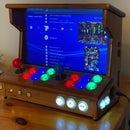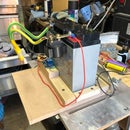Introduction: Go From a 3D Scan to CAD in a Few Simple Steps
3D scanners are starting to become affordable and can produce some great results. However there are very few guides on how to get the scans in to CAD and then make something with them. This guide shows a quick-and-dirty way of doing it.
Supplies
3d scanner such as Revopoint Miraco, Pop3, Inspire etc.
Computer
Time
Fusion 360
Instant Meshes
Step 1: The Problem
I would like to make a new strap mount for my DJI MIni 4 Pro controller that holds the controller at its center of mass without making the controller extra bulky. The controller is a complex shape and so a 3d scan is the best way of getting that shape in CAD so we can fit something to it.
Step 2: Scan the Object
The first thing we need to do is get a good scan. For this guide I used a Revopoint Miraco but any scanner will do.
Get a good scan that have all the key areas you want to fit to. It doesn't need to be colour or mega detailed because we're going to simplify it.
Step 3: Instant Meshes
I want to create a T-spline model of the controller in Fusion360. Unfortunately, the mesh to T-spline converter can only deal with quad meshes and the output of Revoscan (and all other scanning tools really) is triangles. We can covert the model to quads using a nice, free tool called Instant Meshes: GitHub - wjakob/instant-meshes: Interactive field-aligned mesh generator
Open up Instant Meshes and select Open Mesh
Step 4: Simplify
At the moment, our target vertex count is way too high at 100k. Fusion360 will have a fit. We want that around the 10k mark ideally. Move the slider to 10k
Then hit "Solve" under Orientation Field
Our mesh will have lots of pretty colours on it now.
Step 5: Triangles to Quads
Hit "Solve" under Position Field
Now we have lots of squares. Squares are good.
Hit "Export" and choose Pure quad mesh (this will ensure that all the facets are quads and that no triangles remain.
Then finally "Extract Mesh"
Step 6: Saving
Save the mesh as a new filename
Step 7: In to Fusion 360
Open the new quad-mesh in Fusion 360 and orient it to X, Y, and Z with the movement tool
Step 8: Create a Form
Next, under the surface tab, select New Form
Then hit Convert
We want Quad-mesh to T-Spline
Hit OK, and Fusion will chew on it for a while, then hit Finish Form
Step 9: We Have a Solid
After Fusion has solved it, we will have a solid that we can do things with such as cut, scale, extrude etc.
Step 10: Make a Larger One
As I want to make something that is only slightly larger than the original controller, we can create a scaled copy of the scan and then use the original scan as a tool to "cut" the new object.
Let’s make it 1.1x bigger. Make sure to scale from the origin rather than a corner.
Step 11: Cut It Up
Do a bunch of plane cuts to chop the larger model up in to something like what we want.
Step 12: Object As a Cutting Tool
Now we have our rough model, let’s put it over the 1.0 scaled original model and then use that model as a tool to cut out from our new part:
We end up with this, ready for an attachment to be added:
Step 13: Do Some CAD
A quick bit of CAD to add the strap mount and we have our part. Make a mirror of it and we have the part for the other side.
Step 14: Print It / Use It
Let’s print it and see how it fits.
If all went according to plan, it should fit perfectly, and in this example it does.













